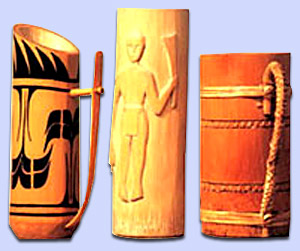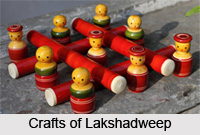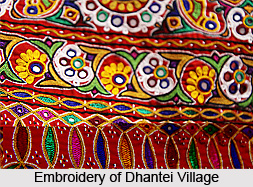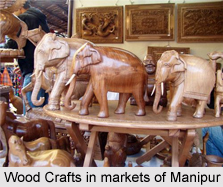 The ancient Wood Craft of India has seen its evolution and development in the northeast Indian state of Manipur, with contemporary designs reserving their due alongside traditional artistic ones sustaining their appeal. With the state been blessed with numerous tik, gambhari, mango and some mahogany timber trees along with many minor and major timber plants, it is natural that wood craft here has only flourished since the ancient period. However, the end designs have varied between hill and valley, although fast-paced modern changes have brought them nearer.
The ancient Wood Craft of India has seen its evolution and development in the northeast Indian state of Manipur, with contemporary designs reserving their due alongside traditional artistic ones sustaining their appeal. With the state been blessed with numerous tik, gambhari, mango and some mahogany timber trees along with many minor and major timber plants, it is natural that wood craft here has only flourished since the ancient period. However, the end designs have varied between hill and valley, although fast-paced modern changes have brought them nearer.
Hill Wood Craft of Manipur
The hills belong to various tribes and in Manipur, there are 3 such - the Nagas, the old Kukis and the new Kukis. The traditions of wood craft vary considerably between the Nagas and the new Kukis, while those of the old Kuki tribe have the Kuki tradition with the influence of Nagas.
The Nagas led a simple life with their collective society living in simple huts typically designed. Every village had a bachelors" dormitory where all unmarried young men used to reside and act as village volunteers. Such dormitories were centrally placed acting as sentry to the village. With the abundance of timber, the dormitory and the house of the traditional village chief were built with large wooden beams, with roof thatched by thatching grass. The front of the roof was usually projected, symbolising Naga tradition. The highlight of such construction was the surface of the wooden beams and the central pillar of the house that was usually carved with various motifs mostly animals, birds etc. They are also painted to give a lively look, but colours commonly used being white and black. The surprising facet is that such finery is not done with fine chisels but by their usual "dao" and spear, the designs brought out by moving these implements at various angles.
The Naga tradition witnessed gradual change as the tribe interacted with others and swift change as Christianity swept across the community. Traditionally, they had simple furniture made of wood logs or stools from cane and bamboo. Adapting to modern designs made them have drawing room and dining room sets, either made of wood or cane and bamboo. The modern furniture was bought from Imphal by those who could afford, and crafted by others locally themselves according to own taste. The tragic change was the slow and steady discontinuation of traditional beam carving, as there were no artisans and that it caused mismatch from modern lifestyle. The bachelors" dormitory also saw its cessation as social changes swept across. However, the art of wood carving sustained in the genes and mind, with those talented enough starting to carve out images from small logs, either kept as drawing room decor or sold to tourists. Often they made modern furniture with carvings such that it reflected something special of their own. This however did not flourish up to desired extent, given the artisans weren"t organised and there wasn"t any financial support as much as that in the valley.
The Mao, Maram, Tangkhul and Rongmei groups of Nagas had the tradition of taking food on wooden platters with wooden spoons and forks. This is also found amongst the Nagas of Nagaland. These tribes believe that Bhima (second of the Pandavas) shall liberate those who take food on wooden platter. They however switched over to modern crockery and stainless steel items, but continued to make wooden plates, forks and spoons as fancy items, being extremely smooth, white and attractive.
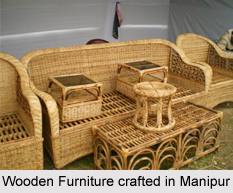 As for the old and new Kuki tribes, they do not have any tradition of carving on wooden beams. They switched over to modern furniture during recent past. The new Kuki tribes may be called the tribes with orchestra, having musical instruments at least 40 to 50 in number in their own tradition, like gongs, xylophones, flutes, drums, stringed instruments and so on. The gongs are brass-made but there are instruments made of wood, which they make with perfect notes and rhythm, showcasing the workmanship. The old Kukis have similar tradition but in less number than the new tribe.
As for the old and new Kuki tribes, they do not have any tradition of carving on wooden beams. They switched over to modern furniture during recent past. The new Kuki tribes may be called the tribes with orchestra, having musical instruments at least 40 to 50 in number in their own tradition, like gongs, xylophones, flutes, drums, stringed instruments and so on. The gongs are brass-made but there are instruments made of wood, which they make with perfect notes and rhythm, showcasing the workmanship. The old Kukis have similar tradition but in less number than the new tribe.
Valley Wood Craft of Manipur
In the valley, the Loi and Panggen (Muslim) tribes have been recognised as experts in carpentry since the ancient days. It is said that during the reign of king Khagemba, 14 Muslim families known to be expert carpenters were allowed to settle in Manipur. It is also believed that expert carpenters are still present in Lilong hamlet of Panggens and Kakching hamlet of Lois. Scholars like T. C. Hodson and Col. Johnson who visited Manipur have concluded that with little training inputs, high-skilled carpenters can be created anywhere in the valley. The artisans and carpenters of the state are skilled enough to manufacture a camera complete in all respects and serviceable, at par with English designs, even though they might not have seen one before. Hodson also noted the traditional furniture used in a Manipuri house - the bed of head of the family being a large wooden structure with four posts and the chest accommodating the family belongings, generally an old wooden box with an iron lock.
Hodson also observed the change from traditional to modern valley wood craft in Manipur, with sofa sets, dining tables and fancy modern cots of standard size well-decorated with carvings, prevalent amongst those from lower middle class and above who can afford. The use of sunmicas or similar items is common. Many residents get their furniture made by local carpenters by showing them modern catalogues, which they buy either in book shops in Imphal or from Calcutta or Delhi. In one respect, there is hardly any shift from tradition. Except amongst few urbanised families of Imphal, almost all Manipuri women are weavers, with loom being their proud possession. Even in cases where women do not produce cloth commercially, they produce at least for her and the members of her family. The loom designs vary as per the type of product, from ordinary towel to cloth with fancy designs. The looms are procured from known carpenters skilled enough to make them with perfect adjustments.
Historical records state Maharaja Joy Singh got a deity of Govindajee, an incarnation of Vaishnava deity Krishna, crafted as instructed by the deity in his dream. The image was crafted from wood of jackfruit tree that grew profusely around, and the skilled carpenter made it as per Maharaja"s description up to his satisfaction. The image was later installed in the palace and is even today the most important place of worship for Vaishnavites. It is the family deity of the royal family.
Manipur having one of the largest sweet water lakes has made boating quite popular. During ancient days, there used to be naval battles on the mighty lake. Boat making became a well known art, and a Loi village called Hiroi Lamgang in the south of the valley mastered the skill, also literally meaning "boat maker of dry land". The village used to make boat for the king for special occasions, well decorated and carved all over. Boat making became a modern industry and many of these artisans switched over to fancy items made with chisels and hammer. Loi villages of Kakching and Shugnu were known for both carpentry and blacksmiths. Shugnu is also a place where a number of displaced persons from East Pakistan resettled and introduced many skilled artworks. Local Loi villagers would get new ideas from this group, crafting many value added items out of wood.
Manipur, famous for its lush dense forests, the wood is a strong, elegant and favourite of the craftsman to produce beautiful articles evolving skills of remembrance. The artisans carve out an array of functional products like utensils, spoons, forks, furniture and drums, with human figures, animal forms and dolls, all reflective of this distinctive art. With wood, the artisans also attach dry roots making the products more attractive. Manipur, has thus, created and recreated beautiful wood craft that may have global demand if suitably promoted, without causing ecological decay and deforestation.
Related Articles:
Wood Craft
Manipur
Nagas
Kukis
Cane and Bamboo Crafts of Manipur
Wood Carving, Indian Tribal Art
Handlooms of Manipur



